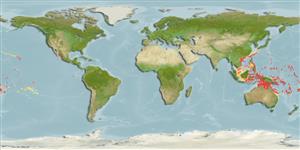>
Gobiiformes (Gobies) >
Gobiidae (Gobies) > Gobiinae
Etymology: Trimma: Greek, trimma, -atos = something crushed (Ref. 45335); benjamini: Named for Peter Benjamin, Toronto entrepreneur, Benjamin Films Ltd (Ref. 100726).
More on author: Winterbottom.
Environment: milieu / climate zone / depth range / distribution range
นิเวศวิทยา
เกี่ยวกับทะเล,น้ำเค็ม เกี่ยวกับหินโสโครก; ระดับความลึก 1 - 90 m (Ref. 86942), usually 4 - 35 m (Ref. 90102). Tropical
Western Pacific: Sulawesi to Tonga; north to Marshall Islands; south to New Caledonia and the Great Barrier Reef.
ขนาด / น้ำหนัก / Age
Maturity: Lm ? range ? - ? cm
Max length : 3.0 cm SL เพศผู้/กระเทย; (Ref. 48637); อายุสูงสุดที่ได้รายงาน: 0.39 ปี (Ref. 87294)
Short description
เครื่องมือที่ใช้ในการแยกชนิดสัตว์,สิ่งมีชีวิตออกจากกัน | สัณฐานวิทยา | ความยาวต่างๆ
เงี่ยงครีบหลัง (รวม) : 7; ก้านครีบอ่อนที่หาง (รวม) : 9 - 10; เงี่ยงครีบก้น: 1; ก้านครีบอ่อนที่ก้น: 8 - 10. Distinguished by having the following characters: a deep concave, ‘U’-shaped interorbital trench; the bony interorbital about half pupil-diameter in width; with a slight groove posterodorsal to the eye; without median predorsal scales, sides of nape covered with small scales reaching to or near to the eyes; cheek and operculum without scales; base of pectoral-fin with oval, moderate-sized scales; prepelvic area with 5-6 rows of cycloid scales, isthmus naked anteriorly, with one slightly enlarged scale on the membrane between the bases of the pelvic fins; central 6-13 pectoral rays branched, uppermost and lowermost rays unbranched; fifth pelvic-fin ray branched once dichotomously and about 60-75% length of the fourth; all other rays usually with one sequential branch, basal membrane connecting the two pelvic fins only at the base; second dorsal spine longest, usually filamentous, extending at most to midway along the base of the second dorsal fin in Australian material; D2 usually I,10; A usually I, 9; nape crest fleshy from the first dorsal origin to above the operculum; when alive, head and body red, preserved yellow, the head with a thin vertical grey (bluish grey in life) bar from the anteroventral margin of the eye to the middle of the jaws and a second bar extending more-or-less vertically downward onto cheek from about the middle of the eye (often persisting in preserved material as faint grey bars); orbit rimmed with a thin band of melanophores, more distinct dorsally but faded in preserved material (Ref. 100726).
Specimens were collected with rotenone (Ref. 13702). Inhabits coastal and outer reef slopes (Ref. 37816, 48637). Benthic, occuring singly or in loose groups, and a plankton-feeder; with prolonged pelagic larval duration of 33.9 days (= 24% of maximum lifespan) and linear post-larval growth; daily mortality rate ranging from 2.9% to 6.3%; sex ratio of 1:1.6 male/females) (Ref. 87294).
Life cycle and mating behavior
Maturities | การสืบพันธุ์ | Spawnings | Egg(s) | Fecundities | ตัวอ่อน
Winterbottom, R., 1996. A new species of gobiid fish, Trimma benjamini, from the western Pacific. Rev. Fr. Aquariol. 23(1-2):57-60. (Ref. 13702)
IUCN Red List Status (Ref. 130435)
Threat to humans
Harmless
Human uses
เครื่องมือ
Special reports
Download XML
แหล่งที่มาจากอินเตอร์เน็ต
Estimates based on models
Preferred temperature (Ref.
123201): 25.4 - 28.9, mean 27.7 °C (based on 442 cells).
Phylogenetic diversity index (Ref.
82804): PD
50 = 0.5000 [Uniqueness, from 0.5 = low to 2.0 = high].
Bayesian length-weight: a=0.01023 (0.00477 - 0.02194), b=3.02 (2.84 - 3.20), in cm total length, based on LWR estimates for this (Sub)family-body shape (Ref.
93245).
Generation time: 0.1 ( na - na) years. Estimated as median ln(3)/K based on 1
growth studies.
ความสามารถในการกลับคืนสู่ปกติ (Ref.
120179): ความสูง, เวลาต่ำสุดที่จะทำให้ประชากรเพิ่มขึ้นเป็น 2 เท่าใช้เวลาน้อยกว่า 15 เดือน (Preliminary K or Fecundity.).
Fishing Vulnerability (Ref.
59153): Low vulnerability (10 of 100).
Nutrients (Ref.
124155): Calcium = 660 [148, 8,086] mg/100g; Iron = 5.4 [1.0, 21.6] mg/100g; Protein = 17.9 [14.6, 20.9] %; Omega3 = 0.145 [0.011, 1.898] g/100g; Selenium = 211 [14, 2,380] μg/100g; VitaminA = 10.7 [0.3, 289.8] μg/100g; Zinc = 12.2 [3.3, 33.4] mg/100g (wet weight);
